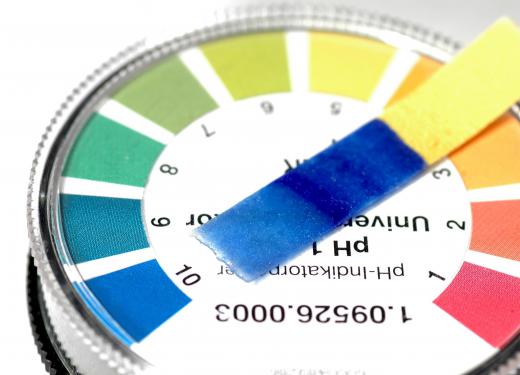What is Titration?
Titration is a method used commonly in chemistry laboratories and classrooms, which uses a solution of a known concentration to analyze and determine the unknown concentration of a second solution. Many times, the solution whose properties are known is a base, meaning it has a pH value of more than 7, while the unknown solution is an acid, meaning its pH is below 7. A typical example involves the gradual addition of the base to the acidic solution, until a neutral pH of 7 is reached, or until a pH indicator turns a certain color, indicating that a certain other known pH has been reached. This can only be done with aqueous solutions of compounds.
A textbook setup for an acid-base titration involves the solution of known concentration, called the titrant, suspended in a buret above a flask containing the unknown solution, or titrand. The buret is a calibrated vertical tube with a stopcock at the bottom of it to regulate the flow of the titrant into the flask. The stopcock on the buret is opened, allowing the titrant to drip into the flask. When this is carefully controlled, it is easy to tell at what point the pH indicator in the acid changes color, marking the end of this stage of the experiment.

The first time the process is done is something like a test run, to roughly determine the volume of titrant needed to change the color of the indicator. This volume is recorded, but will not be factored into the final results. At this point, three more experiments are performed, this time taking into account the amount that was required the previous time to get the desired result. This is best done slowly and carefully, to ensure that the results of the experiment will be as accurate as possible.

Sometimes, it is helpful for the person doing the test to record the volume displayed on the buret when she thinks she has reached at the endpoint, and then test the effect of one more drops of titrant to see if the indicator changes color further. If it does, it will mean she has gone past the endpoint, and her first value was correct, or it may not change color, meaning that more titrant may still be required. After each of these three trials, the readings on the buret are recorded, which indicate the volume needed to titrate the solution in the flask. These values are averaged together to receive the result of the experiment, which can then be used to mathematically derive the concentration of the solution in the flask.
AS FEATURED ON:
AS FEATURED ON:












Discussion Comments
Titrations can also be used to identify an unknown acid.
Did a titration on Tuesday, tedious, but very easy to do and understand.
It is good. What are people crying about? Titration experiments are far more interesting and are quite easy to perform with just a few steps that need to obtained and carried out.
It is hard to do, especially in a high school chemistry titration lab when you have limited supplies. I remember that the droppers we used were so unreliable. The worst part is that I remember we couldn't get any air bubbles in with it or we had to start over.
I think I tried to do an experiment with titration in a high school science class, and I do not remember it going well. This article makes it sound pretty clear to understand, which it is, but in practice it might not be easy for everyone to actually do.
Post your comments